Madagascar Flora
This section gives an overview of some of the Plants of Madagascar
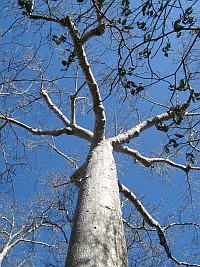
One of the 7 Baobab
species of Madagascar |
Madagascar's mountain ranges split the island into 3 distinct north-south
zones. On the eastern side, swept by the wet southeasterly tradewinds,
lie the island's primary rainforests. On the western coast, in the rain
shadow of the hills, live plants better accustomed to semi-arid conditions. Here
are found the forests of baobabs, denser forest of deciduous trees, and in the
drier areas, the Dideriaceae family of plants that are structurally similar to
the cacti of the Americas, but are in fact unrelated. The third zone is
the "haut plateaux" (French for high plateaus) which has been almost completely
de-forested and is now either barren or home to agricultural efforts of the
Malgasy peoples.
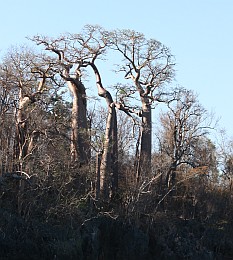
Forests of baobabs |
Although Madagascar is not on the world list of countries with
mega-diversity in the plant realm, (they have about 12,000 species compared to
23,000 species in neighboring South Africa) they do have a very high percentage
of endemic plants (i.e. plants that occur only in Madagascar, and nowhere else).
There are over 60 species of aloe growing in the semi-arid regions interspersed
with the spiny desert plants.
The awkward, upside-down looking baobab is a familiar shape for
anyone who has been to southern Africa or read Antoine de Saint Exupery's "Le
Petit Prince". The one species found in mainland Africa is Adansonia digitata
-- but Madagascar is home to 7 different species of baobab! Although we
didn't get to travel much inland on the western or southern parts of Madagascar
we were thrilled to anchor in Moramba Bay (on the west coast) where the strange
karst islands were covered in baobabs. I don't know which species
they were (and there may have been more than one) but they were great to look at!
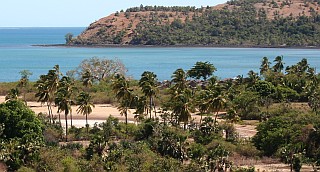 |
On the semi-arid west coast, some of the vegetation
was familiar to us from other tropical islands. On Mitsio Island,
north of Nosy Be we walked through a village and high onto the hills
above the ocean. The paths were of red sand and dirt, and the
bushes were thorny. Coconut palms and banana trees surrounded the
thatch roofed houses. The people use the coconuts for many things,
including fodder for animals, coconut meat for eating and/or drying for
commercial purposes. Other plants near the village included Screw
Pine (Pandanus spp.) used for its wood and fiber, Indian Almond
Terminalia catappa, Beach Morning Glory Ipomoea pescaprae,
and Lantana Lantana camara (an invasive, introduced plant).
Food crops in such small villages also include Mangoes, Papaya and
Bananas. |
 |
In northern Madagascar, in the Réserve Spéciale de l'Ankárana there were a variety of
thorny shrubs, hardwood deciduous trees (in which the lemurs lived) and
immense Ficus trees (left). |
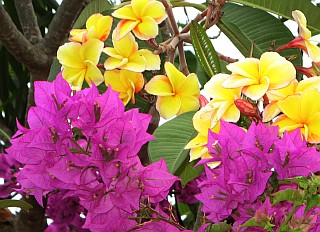 |
| Ubiquitous throughout the tropical world are these two
colorful ornamentals: Bougainvillea Bougainvillea spectabilis (lavendar
in this photo at right) and the fragrant Frangipani Plumeria spp.
(here, yellow and pink). Although neither one is native to
Madagascar, it seems that some early traveler or settler brought these
New World plants to the Old World for decorative purposes. |
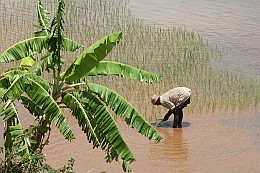 |
On the Haut Plateaux (High Plateau) of central Madagascar you see
many rice paddies, here with a banana tree in the foreground. To
the right, is a typical scene on the plateau, a few deciduous trees,
then vast open areas long ago deforested and now eroding. |
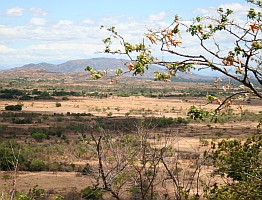 |
 |
One of the few plants able to withstand the dryness and heat of the
limestone tsingy is the Elephant Foot Plant Pachypodium
spp. with its
fleshy stems and rotund base (hence, "elephant foot"). It is found
throughout the arid north, and has a large white flower. |
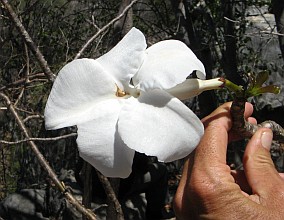 |
 |
| Verdant forest, dense with hardwood trees, characterizes the
eastern and northern rainforest of Madagascar. Here are
found many species of lemur, chameleon and gecko, plus orchids,
fungus and hundreds of plant species. |
|
|
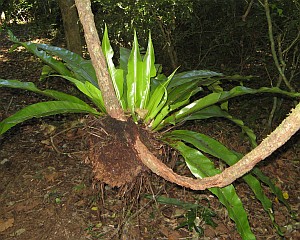 |
| |
The Birds Nest Epiphyte (right) is a common plant in
the rainforest of Montagne d'Ambre, in northern Madagascar. |
|
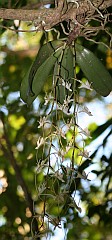 |
Madagascar is home to hundreds of species of orchid. Many are
epiphytic, meaning they grow on other plants, usually trees or tree
branches, their roots in the air. This specimen was blooming high
on Montagne d'Ambre in October. |
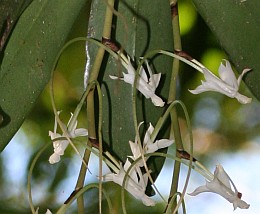 |
Up | Madagascar Lemurs | Madagascar Reptiles | Madagascar Birds | Madagascar Flora |
Madagascar Home | Madagascar Letters | Madagascar Journal | Mad Flora & Fauna | Cruising Madagascar
West Indies Flora/Fauna | Venezuela Flora/Fauna | SW Caribbean Flora/Fauna | Galapagos Flora/Fauna | Fr. Polynesia Flora/Fauna | Tonga & Fiji Flora/Fauna | Australia Flora/Fauna | Southeast Asia Flora/Fauna | Sri Lanka Flora/Fauna | Madagascar Flora/Fauna | Marine Mammals
Top Level:
Home |
Destinations |
Cruising Info |
Underwater |
Boat Guests |
Ocelot |
Sue |
Jon |
Amanda |
Chris |
Site Map |
Make a Comment
 |
Lifetime
Commodores
of the
Seven Seas
Cruising
Association |
 |
|
If our information is useful,
you can help by making a donation
|
Copyright © 2000‑ Contact:
Jon and Sue Hacking -- HackingFamily.com, svOcelot.com.
All rights reserved.




